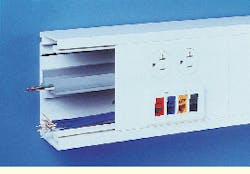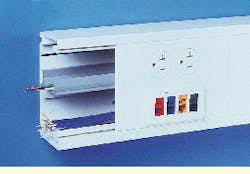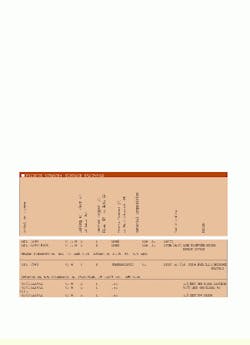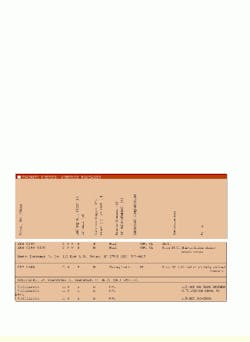Surface raceways provide easy cable access
Surface raceways minimize disruption in the workplace
Barbara E. Thompson
Early in the design process, contractors have to plan how all the wiring will be channeled in the cabling system. First of all, you need to follow appropriate standards and codes. Then, you have to consider what types of wiring the raceway will carry--voice, data or power--and whether those cables require easy access for moves, adds and changes (statistics show that between 40% and 50% of employees move every year). Surface, or perimeter, raceways can provide a modular, accessible system that minimizes disruption in the workplace.
Location is another factor when choosing a raceway. With ceiling, or overhead, systems you can distribute power or communications cables from point-of-entry throughout the building. Floor, or baseboard raceways are common in offices using modular furniture with no built-in raceway, and you can use wall raceways at "chair-rail" height along the desktop. And today, surface raceways are used for open-office environments and where zone-distribution cabling systems are used.
"We`re finding raceway systems being specified for running Category 5 and fiber-optic cables out to a zone-distribution area," says James Burke, Director of Marketing at Interlink Technologies, a Wiremold company. "Contractors seem to like them because they`re accessible; they can lay the cables into it and snap a cover on instead of having to pull the cable through conduit."
When running copper and fiber-optic cables in an open-office environment, you can use a multichannel raceway system that provides access on both sides of a partition. A couple of standards issues regarding the use of multichannel raceways--separation of electrical power and communications cables, cable fill and bend radius--are yet to be resolved, however.
Pathway separation
Collocation of power and data lines has been, and still is, an issue for the telecommunications industry because of the electromagnetic interference (EMI) from power lines that can affect the higher-frequency signals on copper data-communications cables. One way to reduce such interference is to separate low-voltage cables from power cables. It should be noted that fiber-optic cables can be placed in the same raceway as electric-power cables because of the fiber`s immunity to EMI.
"The National Electrical Code, article 800, basically says that power and communications cables in a raceway should be physically separated," says Ron Partridge, product manager at Panduit Corp. But how much should that separation be?
That question is being addressed by the TIA TR-41.8.3 ad hoc task group. According to Partridge, "The TIA will have a few recommendations that will be covered in a new TSB [Telecommunications Systems Bulletin]. It`s expected to generate a lot of debate, so it will be sent out for comments again."
Because of this controversy, some manufacturers are performing their own tests. "It`s a noise-coupling issue at the high-frequency or high-speed data rates," says Burke. "At today`s data rates, the issue of separation of power and low-voltage services is a non-issue, although physical separation of differing services in multichannel raceways is still a must."
Another controversial issue that affects installers is the cable-fill specification set by the NEC, which limits the number of cables that can be placed in a conduit defined by a percentage of the volume of the conduit. The conduit-fill requirement for telecommunications cable is being studied by the TIA TR-41.8.3 task group (see page 67). Currently, the EIA/TIA-569 standard includes a conduit-fill table from the 1993 NEC. The task group is trying to determine whether the NEC article refers to conduit-fill requirements for telecommunications as well as power wiring.
"We are asking for a formal interpretation from the NEC Panel 16," says Paul Kreager of KAI Consulting (Pullman, WA), who chairs the TIA-569 committee. "We will comply with the NEC until the National Fire Protection Association clarifies the issue."
Bend-radius limit
In addition to conduit fill, installers have to consider the bend-radius limit of less than six times of the copper cable diameter. "When you are looking at a 1- or 0.75-inch conduit to support three Category 5 cables, the bend radius is difficult to meet," says Phil Tilton, president of Interconnect Computer Cabling Services (Weymouth, MA). "It`s especially difficult when you hit a corner--a 90-degree bend--and you don`t have the 4 inches you`re supposed to have. It`s difficult in smaller metal raceways and, in the smaller plastic ones, it`s impossible to meet the bend-radius standard."
Security, customer (or installer) preference, safety and cost are all important when choosing a raceway system. Manufacturers offer surface raceways in different materials, such as polyvinyl chloride (PVC), steel or stainless steel, and aluminum.
"In the education marketplace, for instance, steel is usually specified because of codes and security," says Burke. "This is especially true in elementary schools, because, as the saying goes, `if you give a six-year-old a dime, he or she can get into anything.` Higher-education facilities have started to open up their specifications to plastic because of its flexibility and termination selection, and because it is lightweight and easy to install. In the laboratory, however, because of the use of chemicals and corrosive materials, the choice is usually aluminum."
But, as Tilton says, "The type of raceway is usually specified at bid time. We`re used to working with steel. Plastic is OK in some locations but we install in a lot of schools."
Safety is a concern, too, and "plastic, or PVC, is not a conductor," says Tony Siderewicz, director product/market development at Ortronics. "Nonmetallic raceways are becoming more popular because they`re available in various colors and can be painted. Also, you don`t create sharp edges when they`re cut and they are easy to install."
Tilton suggest a tip that he uses for field-installing metal raceways: "With all the corner pieces, right angles, internals, externals and all the rest, we do a lot of fabrication on site. We use what we call a kalamazoo. Basically, it`s an electric band saw that`s on a slow-moving arm that drops it down hydraulically and cuts straight edges."
Customers have their favorite brands also, according to Gary Goetzinger, operations manager at River City Communications Corp. (Sacramento, CA). "They`ll specify the brand name, but sometimes some customers just want what`s least expensive. As long as it is available with the full complement of fittings and a few color choices, we`ll use it."
Goetzinger points out, however, that "it`s a matter of company pride and policy that we conceal everything possible, and sometimes that entails buying drill-bit extensions to get through fire blocks. But, obviously, you can`t get through cinder blocks and plaster; in those situations, surface raceways are more appropriate.
"Cinder blocks pose their own problems with raceways," he continues. "If you`re working in a cold climate, raceways that use double-sided adhesive tape will sweat and peel off. We typically set some anchors in there also to make sure that it`s up there forever."
Cost, or installed cost, is another important issue to consider when specifying a raceway system. "You can really tax a job if you don`t pay attention at the walk-through and estimating stages as to how much raceway you`ll need," says Goetzinger.
Some manufacturers offer labor-saving devices such as adhesive back for smaller raceways. Installers can also use the adhesive back to keep the raceway in place and their hands free to permanently screw it down. "We also make a `concrete` adhesive that is extra strong for rough surfaces," says Siderewicz.
This nonmetallic surface raceway with divider walls creates multiple channels that let you route several cables to the workstation in the same raceway.



